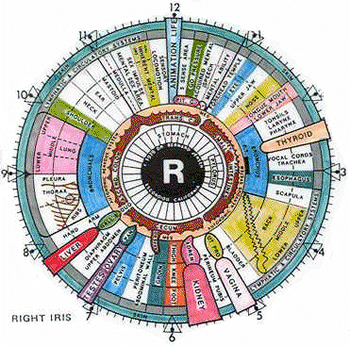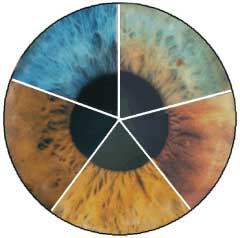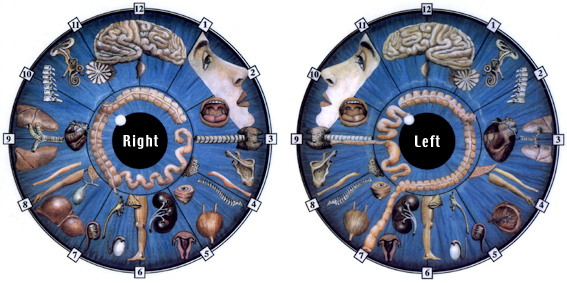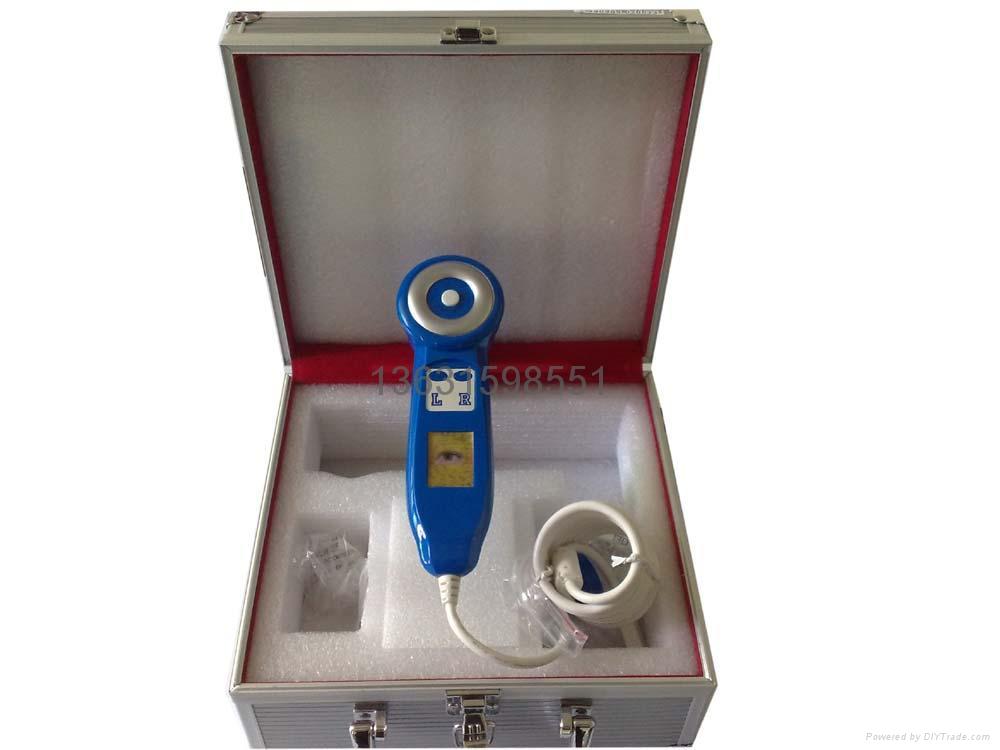Someone said that the iris is the living image of what the eye has been, what it is, and even what it can become. Jon Miles said, "The iris is like a chalkboard which does not get erased."

Iridology is the diagnostic method that examines the patterns and changes in the iris of the eye that may suggest a health issue or disease. Iridology, or iris analysis or iris diagnoses, is a method of alternative medicine that is used to analyze a person’s health status by examining the colors, components of the iris, pupil and sclera of the human eye. When people notice an attractive person, the first thing they may notice is the other person’s eyes, often referred to the windows of the soul. When you look into someone’s eye’s you can often tell how the person is feeling, if they are lying, angry, ill or in love. When people are tired or not feeling well, their eyes will lack the usual sparkle or appear dull. Not only are the eyes the windows of the soul, they are also the map to our bodies.
| Your health |
|
"Hundreds of thousands of Americans die unnecessarily and many more get the wrong treatment". Costs Up but Quality Poor. Harvard University and the Rand Corporation tells us... 180,000 people die each year because of medically induced injury or negligence! "Autopsy studies show high rates, 35% to 40 percent of missed diagnosis, often resulting in death." |

Although some people believe their eye color never changes through out their lives, there are noticeable changes as we grow older or our health changes. These changes can appear as marks or clouds in the iris, the pupils, or sclera of your eyes. Iridologists can assess an individual’s physical, mental, emotional and spiritual health by iris analysis and be able to guide them and show them what measures need to be taken to improve their health.
| Researchers of Iridology look at lots of eyes! Studies have been done around the world (and are still continuing), and all of this has culminated in the science of Iridology practiced today. With the use of microscopes and digital cameras developed over the past 20 years, research has advanced rapidly. |
Iridology (pronounced eye-ri-dol'-ogy) is the science of studying the iris or the colored portion of the eye. According to Mr. Miles, Iridology is based on empirical observations (made by medical doctors and other researchers over the last 300 years) which suggest that certain dysfunctional states in the body are indicated by different textures and color properties within the iris. It is useful for preventative health because these imbalances in the body can be detected early on, giving time for adjustments to be made using natural therapies.
|
The basic premise of Iridology is holistic in nature -- to consider the relationships within the body and where imbalances are located. It does not attempt to address a specific symptom or disease. However, once uncovered, these imbalances (and factors contributing to them) can be addressed, often causing symptoms to diminish or disappear. Iridology is an invaluable tool for designing a plan for well-being. |
 |
Assessing health through studying the eyes is thought to date back at least as far as ancient Greece and Hippocrates. In the 19th century, this art was revived by a Hungarian called Ignacz von Peczely. As a boy, he was said to have observed how the iris of an owl changed, first when it suffered a broken leg and then as it got better. He went on to make observations of the human iris, often being able to predict someone’s impending illness. After qualifying as a doctor, he drew up the first chart of the iris as a key to health. Peczely and those who went on to develop his work in the early years of the 20th century were ridiculed by the medical establishment.
|
| The nerve fibers, or trabecula, respond specifically to tissue and organ conditions with a corresponding physiological reflex manifested in the iris as lesions (pigment changes) and color variations. The pigment changes on the surface occur because of the capillary circulation bringing pigment to these areas. Inflammatory areas can manifest as white signs. Dark markings are caused by loss of substance or deterioration of tissue created by atrophy and disruption of nerve and muscle fibers on the surface of the iris, or depressions, and holes (lacuna) in deeper tissue |
 |
In the 1950's Dr. Bernard Jensen published his own set of maps in the United States. These are some of the most widely used maps for Iridology. Until his death in 2001, Dr. Bernard Jensen was one of America's foremost pioneering nutritionists and Iridologists. Beginning his career in 1929 as a chiropractor, he soon turned to the art of nutrition in search of remedies for his own health problems. He later observed firsthand the cultural practices of people in over 55 countries. In his career he examined and analyzed over 350,000 eyes. In 1955 he established the Hidden Valley Health Ranch in Escondido, California, as a retreat and learning center based upon the healing principles of natur. |
Doctor Bernard Jensen drew up an extremely detailed iris chart in 1950 relating all of the organs and systems of the body to different parts of the iris. Since then, other similar charts have grown out of clinical experience in Europe and the UK. The area around the pupil is said to signify the stomach, and the area around that represents the intestines.
 |
Dr. Bernard Jensen, put it this way: "Nerve fibers in the iris respond to changes in body tissues by manifesting a reflex physiology that corresponds to specific tissue changes and locations." This means that a bodily condition will translate to a noticeable change in the appearance of the iris.
The Innermost Ring -The stomach
The Second Ring – The small & large intestines
The Third Ring – Relates to the blood & its circulation; the lymph glands
The Fourth Ring – The body’s organs & hormone-producing endocrine system
The Fifth Ring – To the musculo-skeletal system•The Outermost Ring The skin & organs responsible for elimination of toxins
| Today respected researchers in this field include: Emanuel Felke (Germany) ... Dr Willy Hauser (Germany) ... Dr Henry Lindlahr (USA) ... Bernard Jensen (USA) and John Andrews (UK) |
The remainder of the iris is divided up into a jigsaw relating to all the other body parts. Modern iridologists say that the appearance of the iris does not change but that its distinctive pattern gives a unique map of a person’s genetic inheritance. By studying this map, we can identify a our constitutional weakness, for example a tendency towards stomach problems or liver damage. However, they also say that some alterations in the body can show up in slight changes of coloring in the iris. For example, a patch that gets slightly lighter can signify inflammation, and an area that gets slightly darker can mean a build-up of toxins. So the old story about the injured owl’s iris may well have a basis in fact.
| What foods should you include or avoid in your diet? Do you need some deep breathing exercises? What type of cleanse is beneficial for your body type? These are questions that may be answered by Iridology. |
Genetic strengths and weaknesses, levels of inflammation and toxicity, the efficiency of the eliminative organs and the state of the digestive system are easily visible in iridology
•Iridology analysis can help tune the treatment by Natural Medicine and help us understand their inherited strengths and weaknesses, thereby becoming more personally aware of how to support their present and future health. In Russia, a trial involving 800,000 patients found Iridology to be 85% accurate in diagnosis and is taught to medical students in some European universities.
•Iridology is especially useful in assessing the state of the digestive system, being able to distinguish between an under acidic or over acidic stomach and clarify the state of bowel health and tension.
•Iridology can often help establish the root cause of disorders and thus aids the choice of effective treatment without recourse to expensive laboratory tests
| The Iris displays, much like a television screen, every single stimulus from the body the brain receives. Since the nervous system connects the iris directly with the brain, the ability to not only view the quality of the connective tissue, but also the functioning of the nervous systems makes Iridology an extremely powerful tool. It is for this reason that any change in the body’s functions, or any disturbance in homeostasis can be seen and interpreted. |
Why The Eyes?
The eyes – and the irises – are direct offshoots from the brain. Hundreds of thousands of nerve fibers make up the optic nerve and many of these end in the iris. Some iridologists say it is for this reason that the eyes – as a result of the information they receive from the brain – are like VDUs, giving an accurate representation of the state of the rest of the body. Others compare it to reflexology, in which the foot is said to be sensitive to what is happening through all the ‘zones’ of the body.
|
The various markings revealed in the iris include: Areas of stress |
What Your Eye Color Tells You
All eyes are categorized as either blue, brown or a mixture of the two.

Lighter eyes are easier for an iridologist to ‘read’. People with blue eyes are said to be more prone to breathing difficulties, while those with brown are more likely to have circulation problems. If your eyes are greenish (a mixture of blue and light brown) then you may be prone to digestive problems.
Iridology Is Good For:
| Bowel problems Eating disorders Vitamin or mineral deficiencies Organs under stress Fatigue Inflammation |
Common health levels and transitions Stages of inflammation Absence of biochemical Toxins and location of them Body constitution Inborn weakness or strength |
Iridology does often not reveal disease and Iridologists do not diagnose. While the iris can reveal some current conditions and stress affecting body systems, it is most useful for prevention and long-term health.
The iris is the "colored" part of the eye. It surrounds the contractile center, or pupil. Light enters through the pupil and is focused by the lens into an image on the retina. The nerves of the iris are connected to a part of the brain known as the hypothalamus. It should be noted that there is no evidence that any nerve in the iris is connected to any other part of the body (organ, bone, etc.).

The left eye is believed to correspond with the left side of the body and the right eye with the right side of the body. In general, the higher organs (brain, thyroid) are at the top of the iris and the lower organs (kidneys) are at the bottom.
In reading the iris to gain insight to the body there are several characteristics that are studied. These include, but are not limited to layers, colors, rings and spots.
LAYERS
A primary theory of Iridology is that the iris is constructed in layers that represent the four stages of tissue activity.
Acute changes
Sub-acute changes
Chronic changes
Degenerative changes
By visualizing which layer has the defect, one can then decide what the nature of the problem is.
COLORS
There are 3 main physical eye types:

? Blue-Eyed Type (Lymphatic): At increased risk for problems with the upper respiratory tract, digestive tract, urogenital tract, lymphatic tissues, joints, kidneys and adrenal gland imbalances.



